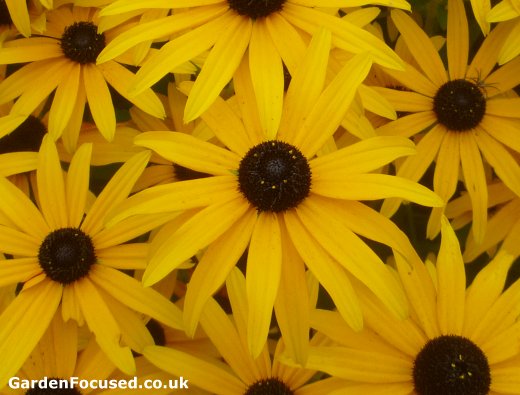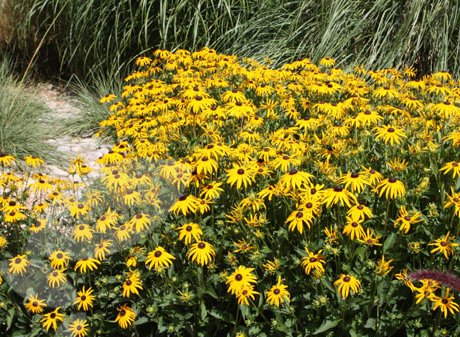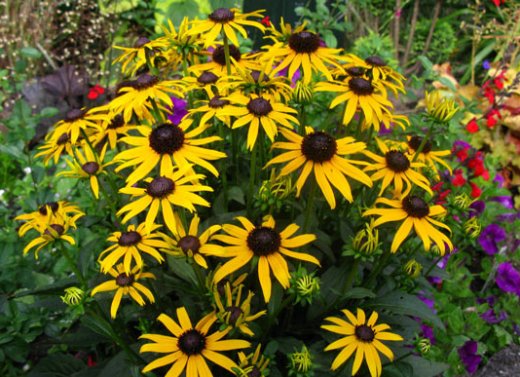RUDBECKIA FULGIDA
There are several varieties of Rudbeckia , this article concentrates on the three most common, Rudbeckia fulgida var. sullivantii ‘Goldsturm’, Rudbeckia fulgida var. deamii and Rudbeckia fulgida. Their flowers are all yellow / orange with a dark brown centre and they all make excellent garden plants.
Commonly referred to as coneflowers or black-eyed Susan, they flower from late summer to the first frost.
Use the checklist below to decide if Rudbeckia fulgida is suited to your preferences and garden conditions:
- They grow to roughly 75cm / 30in high (see below for height of specific varieties).
- Yellow / orange flowers appear in mid August and last to October. They are not scented.
- The leaves die down in November time.
- Rudbeckia fulgida require ground which is moist and well-drained throughout their growing season. They grow in all types of ground from clay to sandy soils.
- They prefer full sun or semi-shade.
- They are low maintenance if the soil is naturally kept moist.
- All parts of the plant are poisonous when eaten, but large quantities would need to be eaten to cause problems to humans. Unlikely because they taste horrible.
- They make good cut flowers.
- They can successfully be grown in containers.
- They are fully hardy in all parts of the UK down to -22°C / -11°F. USDA hardiness zones 4 to 10.

![]()
Rudbeckia fulgida var. deamii
WHERE TO BUY RUDBECKIA FULGIDA
Very common at garden centres and online. From personal experience we recommend Crocus who sell them online in 9cm and 2 litre pots, more details can be found here.
HOW AND WHEN TO PLANT RUDBECKIA FULGIDA
Planting from pots is the most reliable method as described below
- Choose a sunny to partial shade position. Somewhere where the soil is normally moist but not waterlogged.
- If the soil is very heavy or is not free draining add lots of well rotted compost to the area and dig it in well.
- It can be planted all year long if the soil is not frozen and you can water well when conditions are dry. Mid March to April and mid September to October are the best times to plant potted Rudbeckias.
- Dig a hole twice the width of the rootball. Sprinkle in a handful of blood, fish and bone and work into the ground.
- Place the plant into the hole, filling in with soil so that it is at the same depth as was in the pot. Fill around the rootball and firm the soil down gently but firmly. Water well to settle the surrounding ground around the rootball.
- If planting more than one plant space them 50cm / 18in apart
DIFFERENT VARIETIES OF RUDBECKIA FULGIDA
All Rudbeckia fulgida can treated in the way but they have slightly different characteristics as outlined below.
RUDBECKIA FULGIDA VAR. SULLIVANTII ‘GOLDSTURM’
This variety has a height of 60cm / 24 inches and a spread of 50cm / 18 inches. The flowers are deep golden yellow and 10cm wide. It is fully hardy in all areas of the UK.

Rudbeckia fulgida var. sullivantii ‘Goldsturm’
Best planted in groups of three or more they come into flower in mid August and last through to October. Best colour is achieved in full sun. They can be bought online from Crocus by clicking here.
This variety can also be grown from seed which will come true to type. Other varieties which are almost identical include ‘Anthony Brooks’ and ‘Goldschirm’. Rudbeckia fulgida var. sullivantii ‘Goldsturm’ was awarded the RHS AGM in 1993.
RUDBECKIA FULGIDA VAR. DEAMII
This variety has a height of 75cm / 30 inches and a spread of 50cm / 20 inches. The flowers are deep yellow and 5cm wide. Although the flowers are slightly smaller than other varieties they are many more of them and they cover the entire top of the plant. This is our favourite variety for planting in a border and was awarded a RHS AGM in 1993.

![]()
Rudbeckia fulgida var. deamii
Best planted in groups of three or more they come into flower in mid August and last through to October. Best colour is achieved in full sun although they also tolerate partial shade very well. They can be bought online from our recommended online supplier, Crocus, by clicking here.
RUDBECKIA FULGIDA
We do believe that the two Rudbeckia varieties above are the best for planting in garden beds, however if you want to plant Rudbeckia in a container then probably your best bet is Rudbeckia fulgida ‘Little Goldstar’. It was first introduced in 2011 by Jelitto Perennial Seeds.

Rudbeckia fulgida ‘Little Goldstar’
Shorter than the average Rudbeckia fulgida, this new variety is only 50cm / 18 high. It produces masses of flowers (typically 5cm / 2in wide) from August to October almost covering all of the foliage. It’s true yellow and looks stunning. They can be bought online from our recommended online supplier, Crocus, by clicking here.
CARE OF RUDBECKIA FULGIDA
The key need of Rudbeckia fulgida is a moist but not waterlogged soil. If conditions become dry for an extended period of time, give them a good watering.
They require little or no feeding. An annual feed of a good handful of fish, blood and bone will help them along nicely. Certainly, do not feed with nitrogen rich fertilisers, this will only encourage leaf growth at the expense of flowers.
Regular dead heading of the flowers will greatly help to encourage more flowers and extend the period in which they are produced.
GROWING RUDBECKIA FULGIDA IN CONTAINERS
Rudbeckia fulgida plants are ideal for growing in containers. We would suggest growing the variety Rudbeckia fulgida ‘Little Goldstar’ because it is more compact than other varieties.
Because of their preference for a well drained but moist soil they will need to be watered regularly and good drainage holes in the pot or container are a must. They grow well in any good multipurpose potting compost.
Don’t feed for the first two weeks after the initial planting. Then feed with a general liquid plant feed every three to four weeks.
A 45cm / 18in wide container is about the smallest advisable. The larger the container the happier the plant will be it will require watering less frequently. A container 30cm / 12 in deep is fine but again, the deeper it is the less frequently it will need watering.
HOW TO DIVIDE RUDBECKIA FULGIDA
If, after three or four years or so, the number of flowers produced starts to decline, then it may be time to divide your Rudbeckia Fulgida. The best time to do this is in Spring, April is normally about right. They can also be divided in autumn.
Before dividing it, make sure the plant is well watered the day before. Trim off all the foliage to about 15cm / 6in from the rootball.
Dig up the rootball with a fork keeping as many of the roots attached as possible. Then it’s simply a matter of cutting the rootball into two or three equal parts. This can be done by prising it apart with your hands or literally cutting it with something like a hacksaw.
Replant each of the parts in their new positions to the same depth as the original plant and water in well. Space them 50cm / 18in apart, Don’t feed until the plant has developed new leaves.
PESTS AND DISEASES OF RUDBECKIA FULGIDA
Rudbeckia fulgida are strong growing plants and are rarely attacked by pests. Sometimes, but not often, they can suffer from leaf spot.
LEAF SPOT
The symptoms of this problem are dark spots on the leaves. Affected leaves eventually fall off and in bad cases the plant can be severely affected. The latest research indicates that in most cases the damage is caused by damp, humid and / or cold conditions rather than disease.
Where the plant is only partially affected the solution is to remove spotted leaves and burn them as soon as they are noticed. Where the damage is more severe you may need to accept that the position of your Rudbeckia fulgida plants is just too damp.
Occasionally leaf spot is caused by watering by hand. If the water falls on the leaves it can leave marks. The solution is to simply to water the soil and not the leaves.
RUDBECKIA FULGIDA SUMMARY
Below we list the key strengths and weaknesses of Rudbeckia fulgida.
| HARDY | |
| CLAY SOIL | Yes |
| SANDY SOIL | Yes |
| DRY SOIL | No |
| SHADE | Best in full sun or partial shade |
| EVERGREEN | No |
| EASY CARE | |
| SMALL GARDENS | Yes |
| POT / CONTAINER | Yes |
| FLOWERING | |
| FLOWER TIME | August to October |